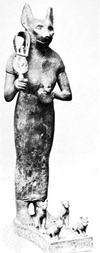- Bastet
-
Bas·tet (bäʹstĕt)
n. Mythology
An ancient Egyptian goddess, daughter of Ra and agent of his vengeance, often depicted as a lioness or cat.
* * *
Her nature changed after the domestication of the cat с 1500 BC. She had cults at Bubastis in the Nile delta and at Memphis. In the Late and Ptolemaic periods, large cemeteries of mummified cats were created at both sites, and thousands of bronze statuettes of the goddess were deposited as votive offerings. Bastet is represented as a lioness or a woman with a cat's head, usually holding a bag, a breastplate, and a sistrum (wire rattle). The Romans carried her cult to Italy. Bastet, cat-headed goddess of Bubastis, statuette, 22nd–25th dynasty; in the British MuseumReproduced by courtesy of the trustees of the British Museum
Bastet, cat-headed goddess of Bubastis, statuette, 22nd–25th dynasty; in the British MuseumReproduced by courtesy of the trustees of the British Museum* * *
▪ Egyptian goddessancient Egyptian goddess worshipped in the form of a lioness and later a cat (feline). The daughter of Re, the sun god, Bastet was an ancient deity whose ferocious nature was ameliorated after the domestication of the cat around 1500 BCE. She was native to Bubastis in the Nile River delta but also had an important cult at Memphis. In the Late and Ptolemaic periods large cemeteries of mummified cats were created at both sites, and thousands of bronze statuettes of the goddess were deposited as votive offerings. Small figures of cats were also worn as amulets; this too was probably related to the cult of Bastet.Represented as a woman with a cat's head, Bastet carries an ancient percussion instrument, the sistrum, in her right hand; a so-called aegis, or breastplate (in Bastet's case, surmounted with the head of a lioness), in her left hand; and a small bag over her left arm. She wears an elaborately ornamented dress. Her cult was carried to Italy by the Romans, and traces have been found in Rome, Ostia, Nemi, and Pompeii.* * *
Universalium. 2010.
